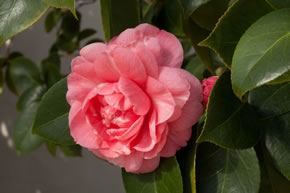Chiswick House Announces This Year's Camellia Festival
Celebrating the 200th anniversary of the Conservatory, Sir Peter Blake donates a print
This year's Chiswick House Camellia Festival will take place from February 16 to March 17 2013, in the spectacular setting of the 19th century Chiswick House Conservatory.
The Conservatory at Chiswick House Gardens was designed by Samuel Ware for the sixth Duke of Devonshire and completed in 1813. Ninety-six metres long, with a glazed dome at its centre and glass pavilions at either end, it was a forerunner of those designed by Decimus Burton at Kew and Sir Joseph Paxton at Chatsworth.

Picture; John Fielding
The Camellia Festival attracts visitors from all over the country to see the collection in full bloom, widely regarded as one of the finest in the country and certainly the oldest in the West. It includes rare and historically important examples of these beautiful plants, with a fabulous array of blooms; pink, red, white and striped. Many of these are descended from the original planting in 1828. Among these is the unique Middlemist’s Red, originally brought to Britain from China in 1804 by Londoner John Middlemist, a nurseryman from Shepherds Bush. It is one of only two in the world known to exist – the other being in Waitangi in New Zealand.
This year, as part of the 200th anniversary celebration, there will be an exhibition of early pictures and photographs showing the Conservatory through the centuries, culminating in its complete restoration in 2010.
Sir Peter Blake has donated an original watercolour of a Camellia, which will be made available as a print during the Festival, to raise funds for the Trust. The Camellia shop will sell a range of modern plants for home growers. It will also feature postcards and a limited edition Camellia bag designed by the acclaimed designer, Marthe Armitage, who also lives and works in Chiswick.
Throughout the Festival, there will be daily tours with expert festival guides, and a special display of contemporary Camellias, organised by specialist growers Trehane Nursery.
The Chiswick House Camellia Festival 2013
Chiswick House Gardens, London W4 2QN
Dates: 16th February –17 March 2013
Conservatory opening hours: Daily 10:30 am –4pm
Chiswick House: exclusive ‘Festival’ weekend openings 10am – 5pm
Advance bookings and information: chgt.org.uk
Tickets £8 (under 16’s free) including free Camellia and Conservatory guide
TicketWeb or call 0845 477 1000
For details of group bookings (discounts for 10+) and group tours Tel: 020 8742 3905
All funds raised help to support Chiswick House and Gardens Trust, a registered charity dedicated to the preservation and continued enhancement of the historic Chiswick House Gardens, open free to the public every day until dusk.
Camellias have been grown in China, Japan, Korea and Vietnam as a garden plant for thousands of years. The name of ‘Camellia’ was given to the genus in the 18th century, in honour of Georg Josef Kamel, a Moravian Jesuit apothecary and botanist, who worked in the Far East.
The Camellias that grow at Chiswick are all of the species C. japonica. The original collection was ordered by William Lindsay, the 6th Duke’s Head Gardener, from Alfred Chandler’s Vauxhall nursery. The number and name of all the varieties were not detailed but visitors’ descriptions include references to varieties of C. japonica such as ‘Alba Plena’, ‘Welbankiana’, ‘Lady Granton’, ‘Lady Hume’s Blush’, ‘Woodsii’, ‘Beali’ (now ‘Beali Rosea’), ‘Nobilissima’, ‘Imbricata’, ‘Chandleri’ and ‘Elegans’. Today’s Conservatory collection of 33 different varieties, which includes many of the earliest varieties introduced to Britain. Using stem girth as an approximate guide it is probable that the camellias identified as C. japonica ‘Variegata’, ‘Imbricata’, ‘Chandleri’, ‘Alba Plena’, ‘Pompone’, ‘Aitonia’, ‘Corallina’, ‘Rubra Plena’ and ‘Rubra’ are all from the original 1828 planting.
‘Middlemist’s Red’ was originally brought to Britain from China in 1804 by Londoner John Middlemist, a nurseryman from Shepherds Bush. It is believed to have been presented by one of his descendants to Chiswick sometime after 1823 as the Sixth Duke added to his growing collection of camellias. Despite its name, the plant blooms a deep pink and is normally in full bloom during the months of February and March. The only other known plant of this variety is at the Treaty House, Waitangi, New Zealand.
January 29, 2013
Related links
|